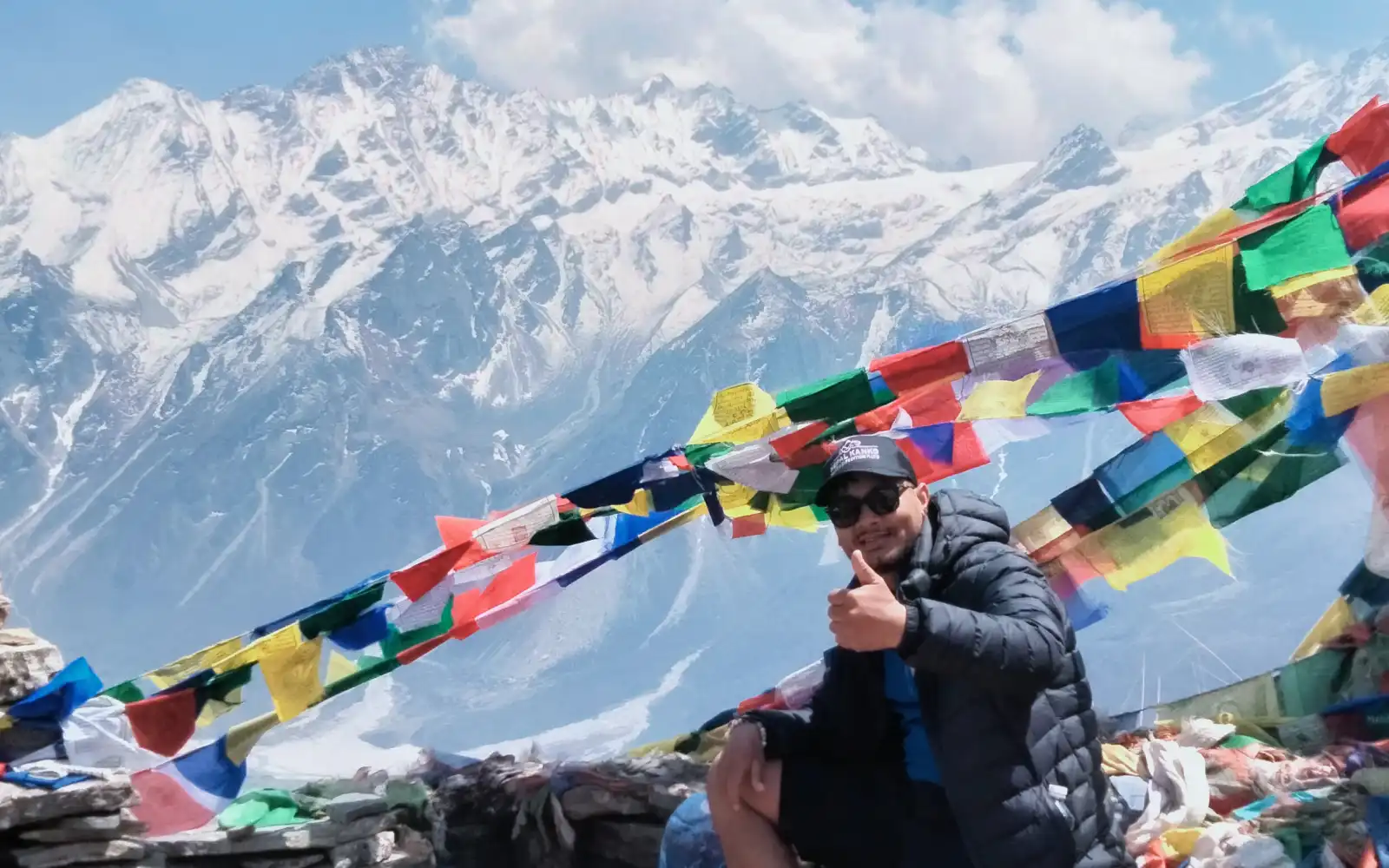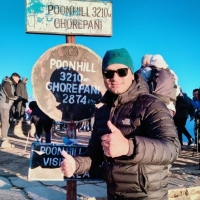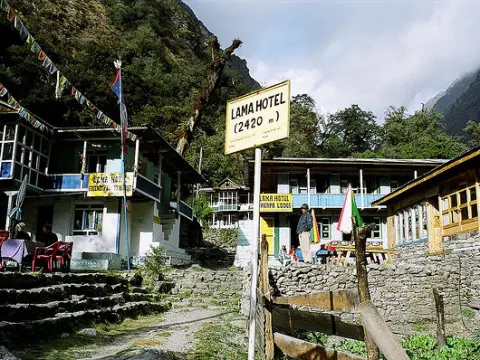Lama Hotel: An Ideal Stop In Langtang Valley
IntroductionLama Hotel is a small Nepali settlement in the Langtang Valley in Nepal. It is located at an elevation of around 2470 meters above sea lev...


Meanwhile, the trek to Kyanjin Ri from Kyanjin Gompa is moderate but steep in certain sections. Nevertheless, 3 to 4 hours are usually taken by most trekkers to get to the top. The trekking trail starts from the village and continues through rocky ground and alpine meadows. As you go along, you notice prayer flags and Buddhist chortens, which bring spiritual beauty to the trek.
From above Kyanjin ri, the view is fabulous. Langtang Lirung (7,227 meters) dominates the northern skyline. Moreover, other mountains such as Yala Peak (5,520 meters), Langshisha Ri, and Tserko Ri are visible. Deep glacial valleys can also be viewed from there. So, the high elevation is perfect for photography.
Moreover, the climb to Kyanjin ri is appropriate for healthy trekkers. No climbing experience is needed, although there will be shortness of breath because of the elevation. Therefore, acclimatization is necessary. Some trekkers use Kyanjin Ri as a warm-up for tackling higher Himalayas.
In fact, Kyanjin Ri is not only a trek but also culturally and nature beautiful. The setting consists of alpine forests and fauna, such as marmots and mountain birds. Furthermore, the place is peaceful and less crowded than favorite trekking routes.
In short, Kyanjin Ri is a mountain to climb near Kyanjin Gompa. It is blessed with wonderful views and a sense of accomplishment. This trek thus augments the Langtang trekking experience beautifully.
Actually, the scenery around Kyanjin Ri is spectacular and varied. The top gazes over the Langtang Glacier to the north. This is one of the largest in the region. Alpine grasslands and rock ridges slope down from the top. The meadows and ridges are covered with moss, wildflowers, and low-growing bushes in the summer.
Besides, Kyanjin Ri is surrounded by taller peaks like Langtang Lirung (7,227 meters or 23,711 feet). Yala Peak (5,520 meters) lies to its east. Langshisha Ri and Tserko Ri are near it too. These mountains create a lovely natural amphitheater around the valley.
Moreover, the trek to Kyanjin Ri consists of a mix of terrain. The trek starts from the Kyanjin Gompa village, going on via green meadows and rock tracks. The climb is gradual but steep in some places. Snowfall continues throughout the year for this part of most of the region. Winters tend to be cold, with high winds and low temperatures.
Briefly, Kyanjin Ri lies in a stunning mountain landscape. Its location offers tremendous views of major Himalayan peaks and glaciers. The blend of alpine terrain and rugged geology renders it a secluded trekking point. Therefore, both trekkers and nature lovers are attracted to it.

Meanwhile, the trekkers journey from Syabrubesi along the Langtang River trail. The trek passes through forests, villages like Lama Hotel and Langtang Village, and subsequently, the picturesque landscape. It takes at least six to seven days on average to arrive at Kyanjin Gompa. Increased altitude along the way allows for acclimatization.
But, the trek to Kyanjin Ri begins from Kyanjin Gompa. The trail is well used but steep in some places. Trekkers typically take 3 to 4 hours to the summit. The trail traverses over rocky terrain, alpine grasslands, and sparse bushes. Prayer flags and Buddhist chortens add cultural adornments along the way. The trail is moderately demanding, so good physical condition is recommended.
In fact, no vehicles or public transport reach Kyanjin Ri. All the equipment, food, and supplies must therefore be carried by porters, yaks, or brought by trekking visitors themselves. This adds to the remoteness and sanctity of the experience. Climactic conditions in this region change rapidly, with snow and ice being dominant in winter and spring. Summer months are more suitable for trekking.
In short, Kyanjin Ri can only be accessed on foot from Kyanjin Gompa. The path is tough but worth it. Hikers get to see stunning scenery and cultural points of interest en route. The adventure becomes safe and worthwhile with proper preparation and acclimatization.
But the trail of Kyanjin Ri is well-trodden and signposted. There are resting spots along the trail with prayer flags and stone chortens. These are serene points to pause and meditate. The natural surroundings provide shade and shelter on the trail.
However, facilities for trekking to Kyanjin ri exist at Kyanjin Gompa, which is below Kyanjin Ri. There are several tea houses and lodges offering rooms and blankets. It's common for most of the lodges to have hot showers from solar power or gas heaters. Solar power supplies power to a large extent, and power supply is hence weather-dependent.
Here, restaurants at Kyanjin Gompa are varied. Travelers can enjoy local Nepalese food like dal bhat and momos. Western food like sandwiches and pasta is also served. Hot beverages like tea, coffee, and soup warm the trekkers in cold weather.
Moreover, Wi-Fi access here in Kyanjin Gompa is slow and limited. Electronic device charging is provided in all lodges but for a nominal fee. Permits, guides, and porters are also provided by the lodges. Trekking equipment, snacks, and souvenirs are provided from small shops.
Likewise, medical facilities at Kyanjin Gompa are limited to a small health post. Simple first aid and advice are all that is provided. Serious injury or illness needs to be evacuated by helicopter to Kathmandu.
In short, while there are no facilities on Kyanjin Ri, a nearby Kyanjin Gompa offers the simple amenities. They make the trek comfortable and safe. Trekkers will be well rested prior to or post ascending Kyanjin Ri.

Also, other summits in the area like Yala Peak (5,520 m), Langshisha Ri, and Tserko Ri become visible from Kyanjin gompa. The high vantage point also offers sight into glacial valleys that were formed by the ancient ice streams in long past times. These landscape-full places attract photographers and explorers.
Likewise, another highlight of Kyanjin ri is the untouched alpine landscape that envelops Kyanjin Ri. In summer, wildflowers in shades of violet and purple bloom all over the meadows, enamoring the rough terrain. Trekkers may catch a glimpse of Himalayan animals like marmots, mountain birds, and even blue sheep on occasion. The high biodiversity further enhances the natural beauty of the place.
In addition, the spiritual climate enhances the experience of Kyanjin ri climb. On the way, prayer flags flutter in the wind, and rock chortens mark resting spots. These Buddhist signs add a tranquil and reflective ambiance. Visitors can sense the integration of nature and culture.
Meanwhile, the hike to Kyanjin Gompa itself is an attraction for many. It challenges trekkers with its moderate difficulty and altitude. Successfully reaching the summit gives a great sense of achievement and fulfillment. This accomplishment makes the visit memorable.
In conclusion, Kyanjin Ri’s major attractions include spectacular mountain views, rich alpine flora and fauna, cultural symbols, and a rewarding hiking experience. The combination makes Kyanjin Ri a highlight for those trekking in Langtang Valley.
On top of that, the majority of trekkers take photos of the scenery view from Kyanjin ri. Dawn and dusk light create the view stunning. Mountain, glacier, and alpine meadow are photographed by photographers. Wildlife observation is also frequent. Marmots, snow pigeons, and mountain birds live nearby the trail. Observing the animals makes the experience exciting.
Likewise, cultural foraying is also part of the activity. Trekkers notice Buddhist prayer flags and chortens on their way. These figures are peaceful, spiritual surroundings. Some tourists get involved in local prayer ceremonies in Kyanjin Gompa monastery, which is nearby. This contributes to the cultural experience.
Similarly, recovering at resting points along the way to Kyanjin ri is normal. Trekkers soak in the clean mountain air and peaceful environment. Most stop to drink water or snack. This conserves altitude effects and maintains energy levels.
In addition, some trekkers combine the Kyanjin Ri climb with other day hikes. For example, Tserko Ri (4,984 m) is nearby and offers similar views. These hikes add variety and excitement to the Langtang Valley trek.
In conclusion, Kyanjin Ri’s major activities include hiking, photography, wildlife watching, cultural visits, and relaxation. These make the visit rewarding and memorable for all types of trekkers.

Additionally, the ascent to Kyanjin ri is not too difficult, and it is thus suitable for most physically fit trekkers. Unlike technical ascents, Kyanjin Ri does not demand any special equipment or expertise. This makes it a favorite among trekkers seeking a fulfilling but not too taxing hike.
Secondly, Kyanjin Ri is located close to Kyanjin Gompa, a cultural hub of Langtang Valley. The location offers trekkers an opportunity to combine nature and culture in one endeavor. Tourists adore visiting the village and monastery as pre- or post-summit activities. The religious setting adds a unique flavor.
Likewise, the surrounding alpine meadows and wildlife around Kyanjin gompa also attract people because of their natural beauty. Wildflowers of various colors bloom in spring and summer. Himalayan wild animals such as marmots and birds are freely visible. All this rich biodiversity makes the trekking experience more wonderful.
In addition, the path to Kyanjin Gompa is nicely marked and safe. It is an ideal acclimatization trek because of the moderate length and ease of ascent. Kyanjin Ri is the preferred preparation for higher elevations by most trekkers. That practical advantage contributes to its popularity.
Last, the peaceful environment and fresh mountain air make Kyanjin Ri stand out. It is a refuge from crowded trails and spotless destinations. Trekkers cherish its peacefulness and beauty.
In short, Kyanjin Ri is highly favored for its spectacular views, easy climb, cultural proximity, affluent landscape, and peaceful surroundings. These all add up to make it a peak worth visiting in Langtang Valley.
However, the Kyanjin Gompa tea houses provide neat rooms with minimal amenities. Twin beds, foam mattresses, and blankets keep the trekkers warm on cold nights. Shared bathrooms are common, and hot showers are available in most places. Showers normally operate on solar or gas heaters, which is suitable during cold weather.
Moreover, trekking restaurants located here in Kyanjin Gompa provide familiar Nepali dishes like dal bhat, noodles, and momos. Western fare like pasta and sandwiches are also provided. Hot beverages like tea, coffee, and soup warm up trekkers after a day's trek. All tea houses have warm dining rooms with wood-burning stoves.
Likewise, wi-Fi exists in some of the lodges here in Kyanjin Gompa but is slow and unreliable. Charging devices is available for a small fee. The lodges also offer assistance with guides, permits, and porters' arrangement. Simple trekking gear and snacks are found in small stores.
In addition to, Kyanjin Gompa's local hospitality of local people is friendly and welcoming. Most tea houses are run by families, providing a homey atmosphere. Trekkers prefer talking and sharing experiences with other travelers.
Truly speaking, Kyanjin gompa has some luxury en-suite accommodation these days like Buddha Lodges in Kyanjin gompa. It is getting developed with mode restaurants and hotels.
In summary, while Kyanjin Ri has no accommodations, nearby Kyanjin Gompa offers good facilities. The tea houses and lodges provide essential comforts. These amenities help trekkers rest well before or after climbing Kyanjin Ri. This makes the overall Langtang Valley trekking experience enjoyable and comfortable.


IntroductionLama Hotel is a small Nepali settlement in the Langtang Valley in Nepal. It is located at an elevation of around 2470 meters above sea lev...

IntroductionLangshisha Kharka is an alpine meadow at very high altitude in Langtang region of Nepal. It lies at around 4,250 meters above sea level wi...

IntroductionBamboo is a peaceful resting place on the Langtang Valley trek in Nepal. It is located at 1,970 meters in the wooded region near Langtang...
